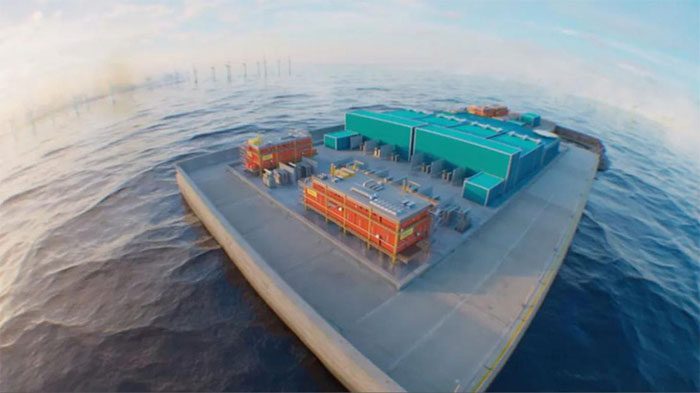Located 45 kilometers off the coast, the Princess Elisabeth Energy Island has become the world’s first energy hub in the North Sea, connecting offshore wind farms to Belgium and other European countries.
Elia, a transmission system operator in Belgium, is constructing an artificial energy island in the North Sea to serve as a central energy hub for Europe.
This energy island will link offshore wind farms in the Princess Elisabeth Zone to the mainland. The Princess Elisabeth Zone is Belgium’s and Europe’s offshore wind energy area, with a projected capacity of 3.5GW.
Spanning an area of 281 km², the island comprises three distinct regions with offshore wind parks along the Belgian coast. It will generate and supply electricity to the mainland through undersea cables.

Simulation image of the energy island in the North Sea – (Photo: ELIA)
Additionally, the island will initially feature two electrical transmission links with the UK and Denmark, as stated in the company’s press release.
This will also be the world’s first artificial island to utilize both alternating current (HVAC) and high-voltage direct current (HVDC).
To enhance the island’s structure, Elia is constructing an outer wall using a series of underwater concrete structures, subsequently filling the area with sand to protect the installations from strong waves, winds, rain, and flooding.
The island will also include a port and a helipad to allow staff access for maintenance activities.
Power transmission infrastructure, such as AC substations, will also be built to minimize energy losses.
The construction is expected to be completed by 2026, with connections to wind farms and the mainland anticipated to be finished by 2030.
The energy island will play a crucial role in achieving Belgium’s renewable energy targets and reducing greenhouse gas emissions.
Moreover, this island will serve as a foundation for a comprehensive offshore electricity system in Europe, linking the power grids of various countries, and is a significant step toward generating 300GW of offshore power by 2050 in Europe.
The European COVID Recovery Fund is financing this energy island, which has also received a grant of approximately 100 million euros from the Belgian government.

Princess Elisabeth Island will be built approximately 45 km off the Belgian coast.
The European Investment Bank (EIB) has agreed to provide Elia Transmission Belgium (ETB), the operator of Belgium’s high-voltage transmission system, with $702 million to construct the world’s first artificial energy island. According to details provided by ETB, the island aims to supply Belgium with 3.5 GW of offshore wind power, facilitating the country’s transition to green energy, as reported by Interesting Engineering on October 29.
The funding will be allocated to the first phase of the Princess Elisabeth Island project. ETB also confirmed that the project is essential for Belgium’s energy transition and Europe as a whole, helping to deliver a substantial amount of wind power from the North Sea to onshore consumption centers. The agreement signing took place on October 25 at the Caisson site of the island in Vlissingen (NL).
According to Elia Group, the Princess Elisabeth Island will be constructed about 45 km from the Belgian coastline. The project will integrate offshore wind energy into Belgium’s power grid, sufficient to supply electricity to over 3 million households. The island will reduce Belgium’s dependence on fossil fuels and lower the costs of green electricity. It will also significantly contribute to the European Union’s renewable energy targets and carbon neutrality.
“The Princess Elisabeth Island will enhance the energy security of Belgium and Europe. This initiative not only strengthens Belgium’s energy infrastructure but also fosters important connections with neighboring countries,” said Robert de Groot, Vice President of the European Investment Bank.


















































